Hongmeng system is not developed based on Linux, but based on microkernel. Hongmeng system is a distributed operating system based on microkernel for all scenarios; Linux is a single-kernel structure, and at the same time absorbs the advantages of microkernel, avoids the defects of microkernel design, and allows everything to run in kernel mode. , call the function directly without message passing.

The operating environment of this tutorial: Magic UI 4.0.0 system, HONOR V30 mobile phone.
Hongmeng system is not developed based on Linux, but based on microkernel.
Hongmeng is an operating system completely independently developed by Huawei, and its English name is Harmony. Huawei said that they are not making another Android or another Linux, but a next-generation operating system. This is a distributed operating system based on microkernel for all scenarios. According to the official introduction, Hongmeng OS has four major technical features, including:
1. The distributed architecture is used in terminal OS for the first time and can Achieve seamless collaboration across terminals to meet all scenarios.
2. The system is smoother, application response delay is reduced by 25.7%, and process communication efficiency is improved by 5 times compared with the existing system.
3. Architecture-level trusted security.
4. One-time development, multi-terminal deployment, and cross-terminal ecological sharing.
It turns out that we know the real architecture of Hongmeng operating system: it uses a microkernel, so is it still based on Linux? How is it related to Linux?
First of all, you have to know what a microkernel is. Does Linux use a microkernel? Let me introduce it to you below.
1. Definition of microkernel
The microkernel structure consists of a very simple hardware abstraction layer and a set of key primitives or system calls. These primitives only include the establishment of Several necessary parts of a system, such as thread management, address space and inter-process communication.
The goal of the microkernel is to separate the implementation of system services from the basic operating rules of the system. For example, a process's input/output locking services can be provided by a service component running outside the microkernel. These very modular user-mode servers are used to complete higher-level operations in the operating system. This design makes the design of the innermost part of the kernel simpler. The failure of a service component will not cause the entire system to crash. All the kernel needs to do is to restart this component without affecting other parts.
The microkernel puts many OS services into separate processes, such as file systems, device drivers, and processes call OS services through message passing. The microkernel structure is necessarily multi-threaded. The first generation of microkernels, The kernel provides more services, so it is called a 'fat microkernel'. Its typical representative is MACH, which is the kernel of both GNU HURD and APPLE SERVER OS. It can be said that it is booming. The second generation microkernel only provides the most Basic OS services, a typical OS is QNX, QNX is well-known in the theoretical community and is considered an advanced OS.
2. Operating systems designed with microkernel
Microkernel is not a new concept. It has existed for a long time. The following operating systems are all designed based on the microkernel structure:
AIX
BeOS
##RadiOS
VSTa
RT-Thread
Attachment: Netizens have come to a conclusion about micro-kernel
3. Explain to you whether Linux is a single-kernel or a microkernel.
As early as 1992, Linus had a famous debate with Tanenbaum about operating system kernel selection. Tanenbaum believes that an operating system designed with a microkernel architecture is theoretically superior to a macrokernel architecture, and advocates that Linux should be redesigned with a microkernel architecture. However, Linus, the founder of Linux, fought back from a practical development point of view, stating the reasons why Linux chose the macro kernel architecture for development, and comparing the performance differences between Minix and Linux.
Tanenbaum, a well-known technical writer, educator and researcher, senior member of IEEE, senior member of ACM, academician of the Royal Netherlands Academy of Arts and Sciences, 1994 ACM Karl V. Karlstrom Outstanding Education Award, 1997 ACM Computer Science Award for Outstanding Contribution to Education, 2002 Texty Excellence in Teaching Materials Award, Outstanding Paper Award at the 10th ACM Symposium on Operating System Principles, and was listed in the "Who's Who in the World" directory.
The following figure is a simple architectural diagram of the two structures of macro kernel (left) and micro kernel (right):

From this, we draw a conclusion that Huawei HarmonyOS is a new operating system. It is not a Linux-based distribution. It is at the same level as MacOS, Windows, and Linux. It is not the same architecture as Android, because Google's Android is based on the Linux kernel, but Google is also developing new operations. On the system front, unlike Android, Google's new operating system is not based on an existing operating system, but a brand new OS. As a result, many people commented that China has entered the era of its own operating system, expressing strong expectations for Huawei's Hongmeng operating system.
For more related knowledge, please visit the FAQ column!
The above is the detailed content of Is Hongmeng system developed based on linux?. For more information, please follow other related articles on the PHP Chinese website!